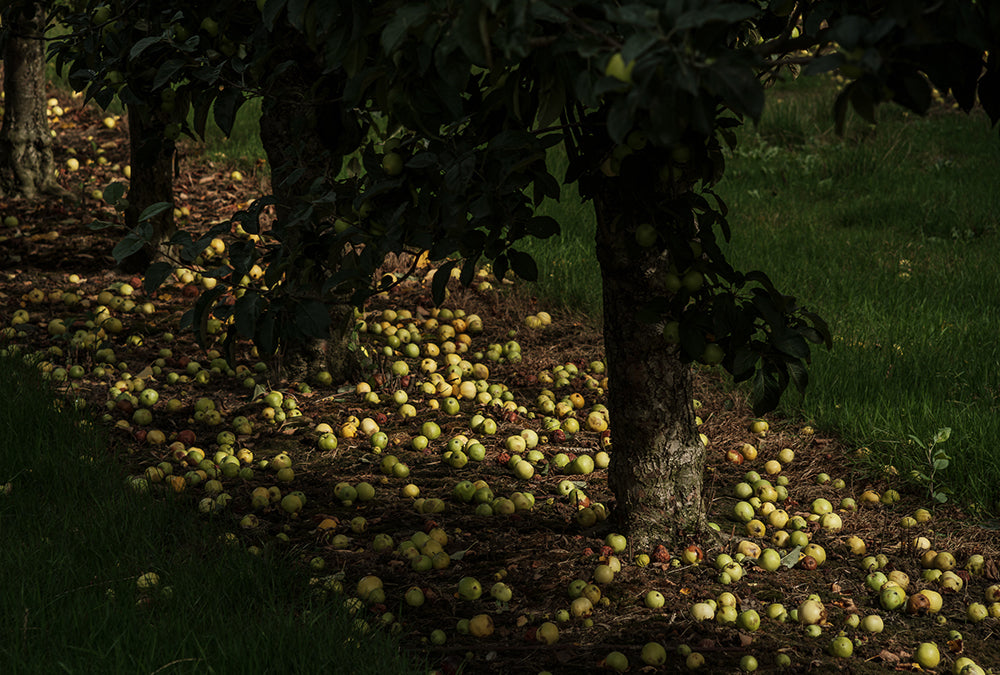
Glorious cider… to many it’s their pint of choice, to others it’s enjoyed in a wine glass alongside food. It comes in a variety of forms – still, naturally sparkling, bottle-fermented, carbonated, dry, medium, sweet, iced, cider brandy, acidic, tannic, and it can be made from just about any apple, from dessert and eating apples, to bold and bitter cider apples. [1]
In whichever form, it’s fair to say the British truly love cider. In fact, British people are the biggest consumers of cider per head compared to any other country in the world. At least 56% of all apples grown in the UK end up in a glass of cider, and we produce around 750 million litres per year! Although for a drink to be legally classed as a cider in the UK, it must contain a minimum of 35% apple juice. [2]
But when was this refreshing beverage first discovered, and how did it become so popular? Read on to find out about the history of vintage cider:
Firstly, when were apples discovered?
About 750,000 years ago, early Palaeolithic food gatherers discovered sour crab apples in what is now modern day Kazakhstan, central Asia, growing wild in the forest. By 1500 BC, apple seeds had been carried throughout Europe, and the Greeks and Romans were starting to cultivate them. During the early centuries of the Christian era, the Romans carried apple seeds and trees to the British Isles, and it was in England that different varieties of apples thrived. [3]
Vintage cider is older than you could imagine
As for cider, evidence shows that as far back as 3,000 BCE, the Celts (believed to be a collection of tribes which originated in central Europe) drank a form of cider, sourced from crab apples.
We also know that it was a favoured drink during ancient Greece, and the first recorded reference to cider actually dates back to the Roman Empire. [4]
Supposedly, the first Romans arriving in Britain in 55 BCE found the locals drinking a cider-like drink and wanted to try it for themselves, bringing it back across the empire.
Cider then spread across wider parts of Europe, and historians have evidence of various monasteries across Europe, and even Germanic tribes enjoying and trading the drink.
The Normans conquered England in 1066, and they also liked the drink, cementing the word ‘cider’ into the English language.
Cider was spreading out to various regions of the UK by the 14th century, including Yorkshire, Worcestershire, Somerset and Herefordshire. The soil condition and climate in the South West of England, in particular, meant that the area was perfect for cider production, and even today it is the leading cider-producing area of the UK.
However, it was wine that still seemed to be the more popular beverage heading into the Tudor age (between 1485 and 1603)… [5]
The Little Ice Age
Then, the ‘Little Ice Age’ happened - a period of cooling that lasted between the 16th and 19th Century. This extreme drop in temperature killed off grapes throughout the UK, but apples however, were able to survive these cooler conditions, and so cider was the more available drink. [6]
Throughout the 17th Century the number of orchards increased, and the preference of cider compared to fine wines grew increasingly more popular amongst the high-classes and royalty.
By the 18th Century, cider wasn’t just for the wealthy, but became the drink for all everyone to enjoy. This is thanks to more efficient production, which enabled a second pressing of cider, using the leftovers to produce a lower alcohol (2 to 3%) cider that was cheap, and could be bought by the less wealthy. [7]
Cider was used as a form of payment
Unbelievably, the practice of paying workers in cider lasted for many centuries, mostly as a means for wealthy landowners to pay their farm labourers cheaply. In fact, the very first written record of cider being used as a form of payment dates back to 1204 CE, from a manor house in Runham, Norfolk.
Some sources suggest that workers could expect to get up to 8 pints per day in payment!
However, paying wages in cider was soon prohibited after the passing of the The Truck Act of 1887. However, this law wasn’t followed by all straight away, and it continued well into the 20th Century. [6]
Modern day vintage cider
Commercial cider production increased in the 20th Century, and the National Association of Cider Makers formed in 1920. With increasing demand, growers started intensively managing their orchards and planting monocultures a lot more. [7]
Nowadays the average UK household takes home around 33 litres of the golden liquid each year! In the past, good weather and key sporting fixtures have helped to drive the popularity, but many producers now report strong sales throughout the year, indicating that cider is no longer dependent on sunshine and sport, and people like to enjoy the drink at all times. [8]
The cider industry is expected to grow strongly over the next five years, with innovation, demand for fruit-flavoured and heritage cider brands and the introduction of reduced-alcohol ciders with a healthier ingredient mix expected to support the sales. [9]
Enjoy this article? Read our next one to find out even more about cider.
Showerings Triple Vintage Cider
Showerings uses aromatic late-season Dabinett apples from a single award-winning orchard in Somerset, the temperate heartland of British cidermaking and just seven miles from Showering’s cider mill.
Want to know more, then contact our team today or take a look at our delicious triple vintage cider.
